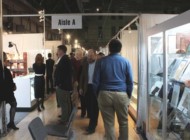
Sentries standing guard at the doors of the Manhattan Art & Antiques Center; an in-house security team also keeps careful watch.
Review & Photos By Z.G. Burnett
NEW YORK CITY — Every few months, collectors and dealers cluster in the halls of the Manhattan Art & Antiques Center (MAAC) in search of the next great find. Almost every gallery at MAAC is filled to the brim with layers of treasures, and one truly never knows what its dealers and visiting sellers will present. “You can’t force it,” attendees agreed about Trade Day’s frequency. “Once a month would be too much, better to let it come together naturally when everyone’s available.”
It’s this comfortable feeling that brings frequent attendees coming back, and newcomers finding their way to Trade Day. Aside from transporting their wares on carpeted dollies down into MAAC’s lower levels, dealers were even more committed on December 7 than usual. Traffic and public transportation shut down somewhere on 55th Street, delaying the event until about noon. Those who made it were rewarded with the opportunity to shop and trade, and a fine lunch of local Chinese food.
While tables were set up downstairs, we took the opportunity to peek into the windows of the mostly shut galleries upstairs, many of which opened throughout the afternoon. Trade Day was also the first day of Hanukkah, and outside of Menorah Galleries was a substantial example of their nominal wares: a large cast bronze menorah from a synagogue in Poland. Only 20 of this cast are known to exist, dating from about 1880, one of which is part of the Polin Museum of the History of Polish Jews collection in Warsaw, Poland. The menorah showed its original patina, with elegant curving candelabra and a molded base. Supporting the arms were two rampant lions which allude to the house of Judah, with a figural finial of Poland’s heraldic white eagle. The combination of the two symbolically asserted that those who worshiped with this menorah saw themselves distinctly as both Polish and Jewish.

Menorah Galleries, founded by Avi Girshengorn and Meir Appel, welcomed customers with this grand, Nineteenth Century cast bronze menorah that was once used in a Polish synagogue.
Ahead of the fray was Butch McGrath, Scituate, Mass., who had already set up his tables and goods while other dealers were still loading in. Among these was a selection of grand silverplate trophies dating from 1898 to 1913, all of which were awarded during women’s tournaments. Their exclusive locations included the Morris County Golf Club, Morristown, N.J., and the Staten Island Cricket and Baseball Club (now the Staten Island Cricket Club), in Walker Park.
Other Trade Day dealers were beginning to move pieces along from their own collections. The table of Dennis and Claudia Vestunis, Brooklyn, N.Y., is always full of wonders, but one piece brought unexpected history local to Newtown, Conn. Dennis grew up in nearby Monroe, Conn., and described playing in the tungsten caves of Old Mine Park, where the crevice of the Champion Lode can still be visible. “I’ve never felt any other cold like it,” he shared. This proximity proved valuable to the young antiques dealer when Newtown’s Fairfield Hills Sanatorium closed in 1995, prompting tag sales of previous patients’ goods. Dennis bought and restored a Federal-era sword cane from one of these sales, replacing much of the mother-of-pearl inlay in star, circle and diamond shapes, and conditioning the deteriorated wood. The cane also showed brass inlay and a carved snake curling up its body or sheath. Another covert object on the Vestunis’ table was a Prohibition-era suitcase from Abercrombie & Fitch, designed to conceal two large flasks of illegal liquor.

Painted by Lorenz Strauch circa 1600-13, this anonymous female sitter chose a fashionable black lace skullcap for her portrait. Solomon Treasure New York, New York City.
Down the staircase from this table was another outside of Solomon Treasure New York, stacked high with canvases of all kinds. One that stood out was a stark portrait of a woman in black, adorned with four heavy gold chains around her neck, two around her wrists and many glittering rings on her fingers, not to mention the pure white ruff and delicate lace cuffs that offset her sober attire. However, her most intriguing accessory was a black skullcap, which appears in many of the artist’s female portraits. Lorenz Strauch (1554-1630) lived and worked in Nuremberg, Bavaria, Germany, where this was a regional style of the time.
Ancient art and artifacts are also available at Trade Day, but few are more precious than those to be found in Anavian Gallery. Founded by Habib Anavian (1915-1995), his son Paul has, since 1992, carried on the family business, which specializes in ancient Near Eastern and Islamic works of art. Anavian is also managing director of MAAC. During his tenure, Habib built a clientele of top tier collectors and museums, which is evident by the rarity of the objects available in the gallery. One such piece was a figural bull’s head rhyton drinking vessel from Western Iran, dated to the Achaemenid period (Sixth to Fourth Century, BCE) with excellent provenance, which is necessary especially when dealing with ancient art. The vessel showed well-molded lips and teeth, as well as realistic tufts of hair alongside stylistic semicircles.

Diorama of an Old West bunkhouse by Deborah Hudgins, displayed by Lev-Tov Antiques, New York City.
Every now and again, folk art appears at Trade Day, and it must be rather special to make the cut. Lev-Tov Antiques presented an American diorama scene showing a group of men, likely Gold Rush prospectors, made by artist and gallerist Deborah Hudgins (1948-2015) of Santa Fe, N.M. Hudgins was the owner of Americana Collectibles, Handmade Dioramas And Miniatures. Another piece that stood out was a Fourth of July scene by American artist Richard E. Howard (1912-1996). Howard’s Nineteenth and early Twentieth Century scenes are minutely detailed, which shows in the dress of what appears to be World War I-era figures. His work often appears at auction, and was recently featured in an exhibition at the Cape Cod Museum of Art, Dennis, Mass.
The Manhattan Art & Antiques Center is at 1050 Second Avenue and 56th Street. The next Trade Day is being planned for February, date to be determined. For more information, www.the-maac.com or 212-355-4400.




























